Journey of labour Guide
-
Preparing for labour and birth
In addition to the natural physical preparation your body makes for birth, you may also find yourself preparing emotionally.
You may:
- feel a strong need to be ready
- find yourself worrying more than usual
- be concerned about making it through labour, or whether your waters will break in public
- be concerned about whether your partner will be able to help you, or whether you will have a bowel movement during the birth and how your partner might react to that
- be worried about the safety of you and your baby during birth
- be worried about having a caesarean birth.
These concerns are common. Discuss your concerns with your midwife or doctor, so you can feel prepared and informed before labour starts.
Your birth preferences
Preparation for labour starts during pregnancy.
Your birth preferences (sometimes known as a birth plan) is a written list of what you would like to happen when you are in labour and give birth.
Birth preferences may include:
- who you would like with you in labour
- what position you would like to give birth in
- what comfort measures you might use as your pain relief options.
It is important to stay flexible
Remember that things may not go according to plan.
There may be complications, or you may change your mind about something. Think about what is important to you for your birth.
Other questions to consider when deciding on your birth preferences may be:
- what if I need a caesarean birth?
- what is the usual practice for an induction of labour?
- what equipment may be used in my labour and for the birth of my baby, and why?
- do I have any cultural or religious needs around giving birth?
- can I expect to hold my baby skin-to-skin after he/she is born?
More information: Pregnancy, Birth and Baby - Making a birth plan
-
Who will support you in labour
It can be helpful to have people around you who can provide both emotional and physical support during labour.
Hospitals usually allow two support people with you in labour. This could be your partner, another family member or a friend.
- Some women choose to hire a doula or birth attendant to support them during labour.
- A doula is not a member of your maternity team but is experienced in supporting women and their partners during labour.
- You can check with your midwife or doctor regarding policies about support persons.
Studies show that women who have someone with them right through labour have a more positive experience of labour and are less likely to need medication for pain relief.
Please note: Due to COVID-19, the number of support people you can have with you during labour and birth may be limited. It is suggested that you choose someone who can stay with you for the whole time.
Being a birth partner
There are many things a birth partner can do to provide support.
They can:
- keep you company and help to pass the time during the early stages
- hold your hand, wipe your face, give you sips of water
- massage your back and shoulders, help you to move or change position, or anything else that helps
- comfort you as your labour progresses and your contractions get stronger
- remind you how to use relaxation and breathing techniques, perhaps breathing with you if it helps
- support your decisions, such as the pain relief methods that you choose
- help you explain to the midwife or doctor what you need – and the other way around – which can help
- help you feel much more in control of the situation
- (if possible) cut the umbilical cord – you can talk to your midwife about this.
More information: Pregnancy, Birth and Baby – Being a birth support partner
-
How your body prepares for labour
Your body is getting ready for childbirth throughout your pregnancy, especially in the last few weeks with final preparation.
The pelvis is made up of two large bones joined by cartilage and ligaments – at two joints in the woman's lower back at the sacrum (called the sacroiliac joints) and at the front symphysis pubis bone.
During late pregnancy a hormone softens and relaxes these ligaments. This gives the pelvic bones the ability to stretch and open more easily for the birth of your baby. It is common in late pregnancy to experience lower back pain, or you may notice that you have a ‘pregnancy waddle’ when walking, due to these changes.
Braxton Hicks contractions
Braxton Hicks are also called ‘practice contractions’ because they are preparation for labour.
Braxton Hicks contractions can begin as early as the second trimester. However, they are most commonly experienced in the third trimester. When this happens, the muscles of the uterus tighten for approximately 30 to 60 seconds and sometimes as long as two minutes. If you have concerns or think you might be in labour, contact your midwife or the hospital.
Braxton Hicks are described as:
- irregular in intensity
- infrequent
- unpredictable
- non-rhythmic
- more uncomfortable than painful (although for some women Braxton Hicks can feel painful)
- they do not increase in intensity, or frequency
- they taper off and then disappear altogether
if your contractions are easing up in any way, they are most likely Braxton Hicks.
How your baby prepares for labour
Your baby may begin moving lower in the pelvis, which is called engagement.
How will I know if baby’s head is engaged?
You might notice this as increasing pressure in your lower abdomen, or you might notice that breathing becomes easier.
- For first time mothers, engagement usually occurs about 36 weeks of pregnancy.
- For second-time mothers, engagement may not occur until after labour begins.
Your baby is designed for the birth process
The baby's skull bones are divided into five plates that cross over during labour, making their head smaller by moulding to fit the birth canal. Mother and baby work together during labour.
-
Getting baby in the right position for birth
There are things you can do during pregnancy to encourage baby into the best position for labour.
How you sit and use your body can affect the position of your baby in the uterus.
While this does not matter so much during early pregnancy, later on it can affect the position that the baby moves into (in the pelvis).
Presentation during labour refers to which part of the baby enters the birth canal first. Normally, the crown of the head will enter first, which is known as cephalic presentation. Other forms of presentation such as breech presentation may cause difficulties with birth.
Once the baby is head down, the best position for a labour is the anterior position.
Anterior position means the baby’s head enters the pelvis facing your back.
This is the ideal and most common position for birth (see image). When baby is in the anterior position, the smallest dimension of the baby’s head leads the way through the birth canal.
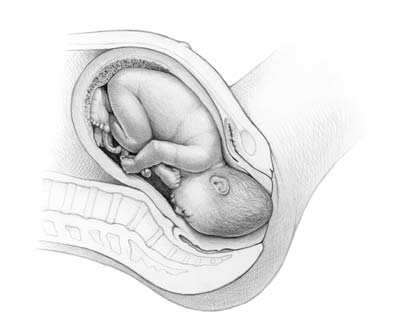
What can I do to get my baby in the best position?
You can use different positions during your pregnancy to give you the best chance of ‘optimally positioning your baby’ prior to labour.
Positions include:
- hands and knees, for as long as comfortable, or sitting on the floor
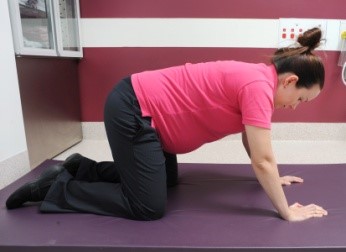
- lying on your side is a better option when on the lounge, than sitting slumped and relaxed back into the lounge chair
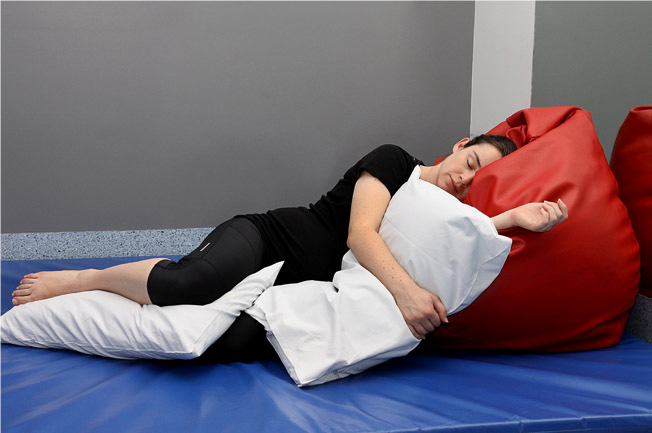
- sitting on a low stool or fit ball, where you are in a supported squat.
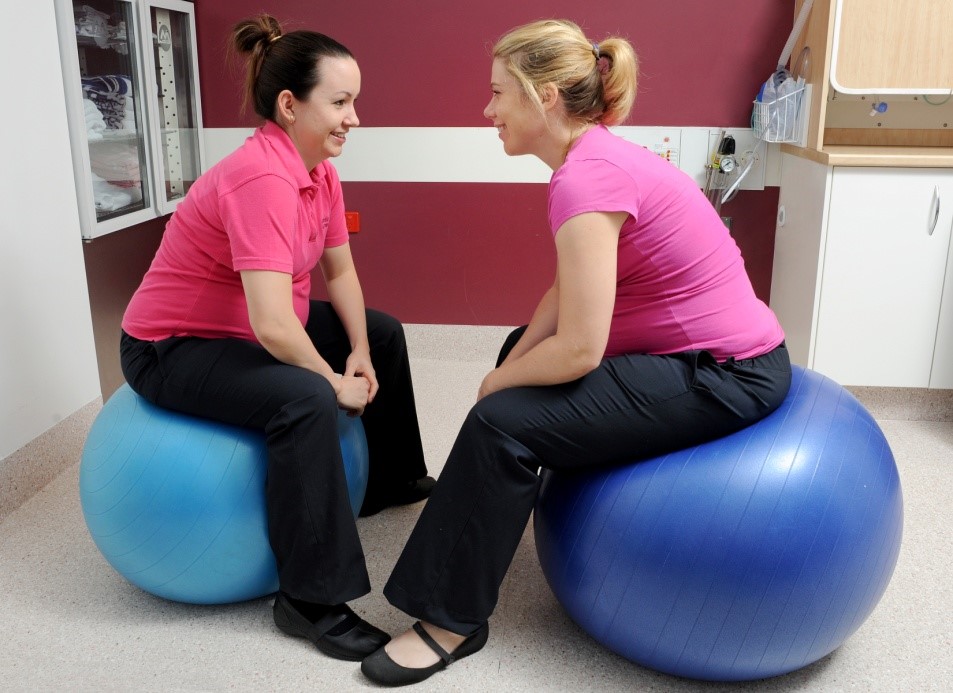
What if baby is in the posterior position
Posterior position means the baby’s head enters the pelvis facing your stomach instead of your back.
It’s good to know that most babies will turn around during labour, but some don't.
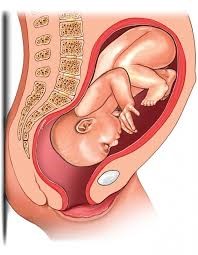
How can this affect my labour?
If your baby is in the posterior position when labour starts, it can lead to a longer labour with more backache.
If baby doesn’t turn, you may be able to push baby out yourself or your doctor may need to turn the baby’s head and/or help your birth with forceps or a vacuum cup.
-
When to seek advice during pregnancy
Seek advice from your doctor or midwife, or come to hospital if you:
- have bright red, fresh blood loss
- feel your baby’s movements have changed, or you are worried about your baby’s movements
- feel unwell (flu like symptoms) or are experiencing a burning or stinging sensation when passing urine
- have severe back pain
- have uncontrollable diarrhoea and or vomiting
- feel your stomach is tender, or you experience severe indigestion pain that you have not had before
- feel faint or have fainted
- are experiencing signs of labour (call early if you have a planned caesarean birth).
IMPORTANT: Call the hospital any time, day or night, to speak with a midwife. You will be asked questions about what is happening. You can then plan when to come into hospital.
Bring your Pregnancy Health Record with you.
More information: Pregnancy, Birth and Baby – What happens to your body during childbirth
-
Final preparations for labour
For mother:
- have your bag packed for hospital from 36 weeks
- go through your birth preferences with your birthing partner(s) and doctor or midwife
- practice your pelvic floor exercises and do some gentle exercise.
For birth partner:
- keep a list of necessary telephone numbers
- check the route to the hospital and have money ready for car parking
- have a labour bag packed for yourself
- make sure your mobile phone is always fully charged.
What to bring to hospital
For mother:
- Pregnancy health record
- maternity bras
- two packs of maternity pads
- current medication
- own pillow (if desired) – labelled
- clothes for labour – old t-shirt, comfortable clothing, warm socks, old underwear, track pants for after birth
- massage oil or lotion
- spray bottle (non-aerosol) for cooling
- tissues and toiletries – soap, shampoo, toothpaste, tooth brush
- food such as barley sugar, jelly beans, fruit bars, glucose drinks
- thongs or slippers
- lip cream for dry lips.
For baby:
- two-dozen newborn size nappies
- six newborn singlets
- six newborn jumpsuits
- six to eight bunny rugs or cotton wraps
- baby wipes / cotton wool
- three face washers for baby bath.
Other:
- camera (charged)
- mobile phone or phone card
- music for use during labour
- baby car seat for discharge
- pen.
Next section: Stages of labour
Journey of labour, 23 Mar 2023, [https://oss-uat.clients.squiz.net/health/children/pregnancy/antenatal-information/journey-of-labour]
This document is uncontrolled when printed. Before using the information in this document you should verify the current content on https://oss-uat.clients.squiz.net/health/children/pregnancy/antenatal-information/journey-of-labour.